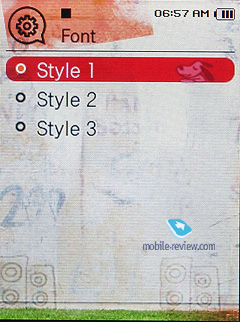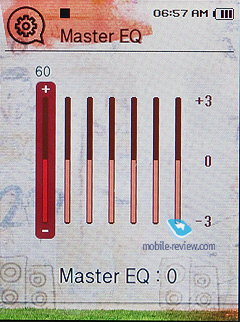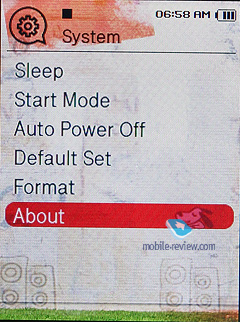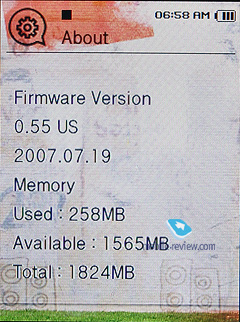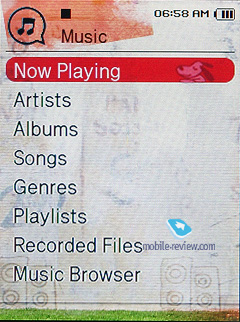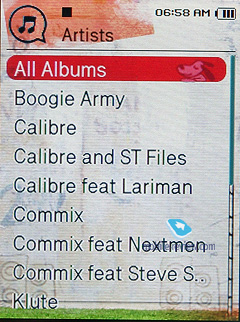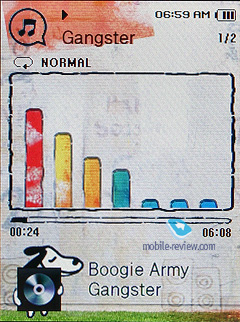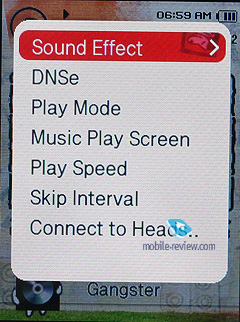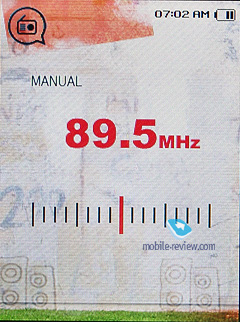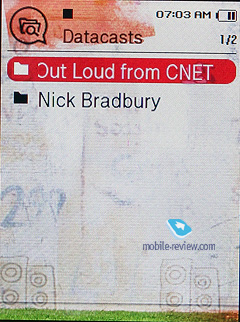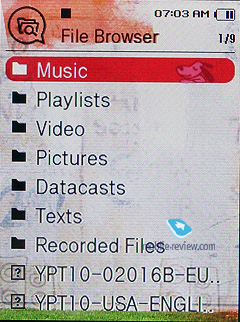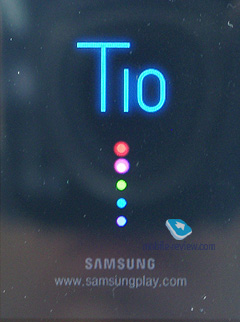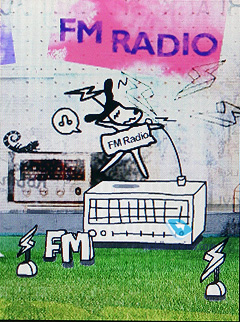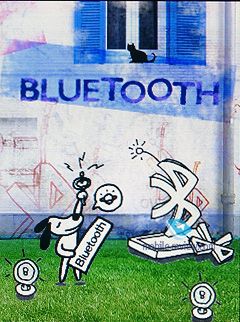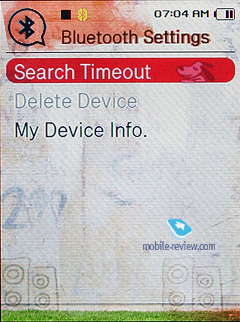|
|
Review of MP3-player Samsung YP-T10
Sales package
- Samsung YP-T10
- Headphones
- USB data cable
- Line-in cable
- Software CD, User Guide included
So much has been said on the player coming in to replace the renowned Indigo, that it would seem there is nothing left to add. The T10 already made it to the spotlight at Moblie-Review.com back when we were reporting from IFA, in the write-up with our first hands-on impressions of the new players. However, we can’t possibly leave this model overlooked, that’s why you are now reading this write-up on the Samsung YP-T10.
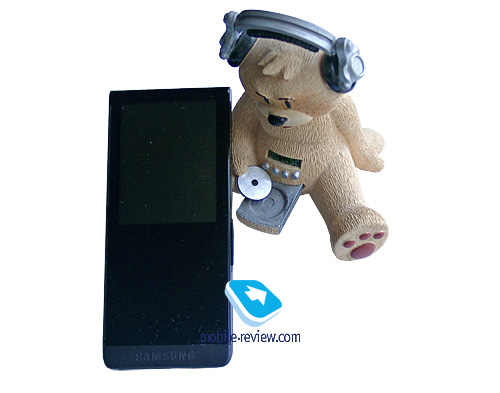
Seemingly, they have tried to cram into the T10 as much experience they have on the market of personal audio as they can, and keep it close to the all contemporary trends and user expectations. It is quite on the cards, that this might turn out to be not the best way to go – Samsung has broken away from the quaint and flashy shapes of the original Indigo (T9) in favor of the market’s demands (however it an open question whether the new design is better than that Nano’s form-factor), or for some technical reasons. If it is the former, then this move doesn’t look particularly thought-out – the T10 debuts at one time with the iPod Nano 3rd Gen that dumps the form-factor it gave birth to in the first place. Apple’s marketing merits can’t be doubted, and it is very unlikely that the company’s experts get multi-figure cheques: this form-factor is already past its pinnacle. The market has been stuffed with similar players, Samsung’s very own K3 X-metal being one of these, with its reasonable sales in Russia and across the globe..
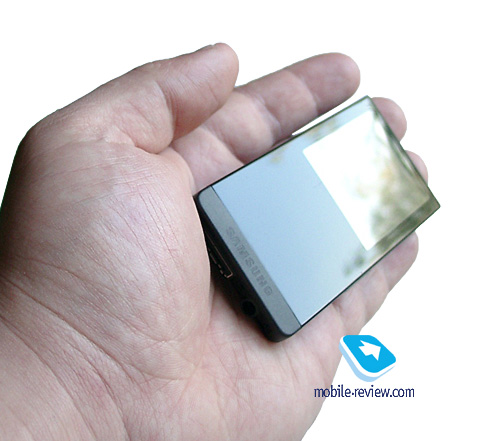
In case these are some ‘technical reasons’, we don’t quite buy that explanation – Samsung has always managed to roll out “more punch with less girth” solutions, just look at the Ultra-branded phones. While comparable in terms of functionality, the A800/A810-series from Sony is way more portable.
But when it comes to the technological talents, the new Indigo, just as you would expect, is Samsung’s most potent player with its 2-inch QVGA display, up to 8 Gb of storage, Bluetooth connectivity, photo/video/text viewers. Plus an FM-tuner and a voice recorder, thrown in for good measure.
And once again, the Korean designers have pulled a few tricks in order to hush up the feel delivered by the edgy rectangular casing. All in all, there will be quite a few points to focus throughout this review.
Casing and Design
The materials used to build the T10 are nothing special – metal and plastic. Even though there is a slew of color schemes available, the black edition is likely to be one of the most popular picks in Russia. In fact, a couple of write-ups wouldn’t bee enough to examine the dislike for flamboyant colors in Russia, and “headshrinkers” could go on with this topic for hours.
Just like many Samsung-branded models have it, the T10’s face is glossy, for it is made of a polished plastic slab that looks so sweet on a shelf. Regrettably, it is, yes you guessed it, prone to fingerprints, smudges and grease, which is the price to pay for its classy looks. Those who really care for their gadgets’ conditions, should stick to the old and proven method – wear clothes made of natural materials and occasionally rub the player down with your shirt’s cuffs.
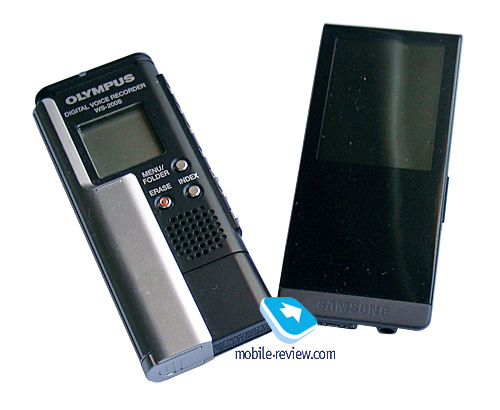
The T10’s rear is made of metal, and what is more the designers have dumped a fairly good, yet rapidly becoming obsolete idea, when the metal slab is left “as is” after some polishing. That’s why the T10 employs a black panel, color-keyed to the front fascia. At least that’s how the things stand with the unit we got our mitts on – other color schemes are likely to have a differently painted rear side.

The player layout is no different from the contemporary standards, since if you manage to find one consumer longing for something all-round new, there will always be a dozen of conservators. So, that’s how come the T10 offers you the same old thing – portrait display on the front with a couple of touch-sensitive pads underneath; no controls whatsoever on the back, just a handful of lines of the device information. However, on closer examination you will also find a smallish Reset hole over there.
The top edge, as well as the left-side spine is free of any kinds of controls, but instead the bottom end is literally crowded with sockets and jacks - a connection port, a headphones jack and a microphone.
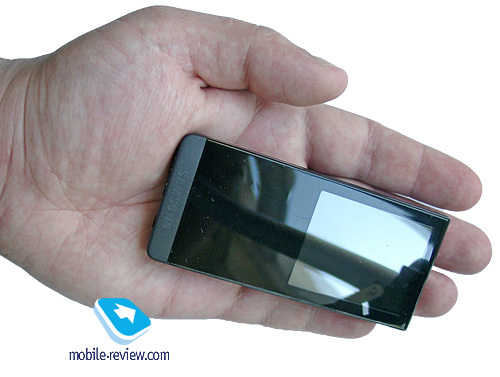
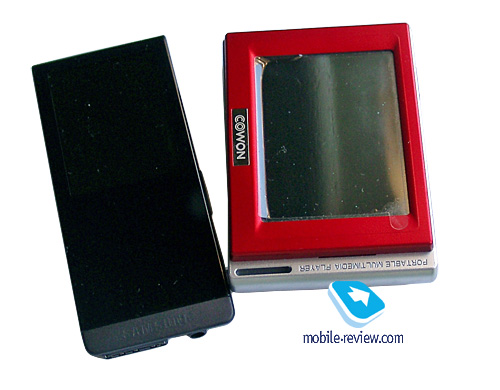
The build quality was never an issue with our T10 – all details are finely crafted and attuned, no creaks or loose parts at all.
And when we finally get to the Design part of the review, we can readily start doing copy/paste from the K3 and the S5 reviews, making some minor updates here and there. The reason being that lately Samsung has been dressing up its players in dignified suits, leaving gaudy Asian ‘kimono’ to Chinese low-end gadgets. Its players have very few outstanding elements, the designs are pretty much versatile as well – there is no shame in taking out of trousers or shorts. Apparently, this is an easy and pretty straightforward way to take a device to the mass market. Flamboyant and flashy gadgets can make a statement in no time and catch some eyes, but normally they won’t be sought-after. That’s why Samsung’s engineers are working so hard on these unfussy and smooth curves. The problem is, however, that in many respects this design has no own face, and loosing unique style is not a big deal when going after versatility. While the S5 is not affected by this, Samsung’s line in this matter is right on the surface – after all, I still miss the T9’s design.
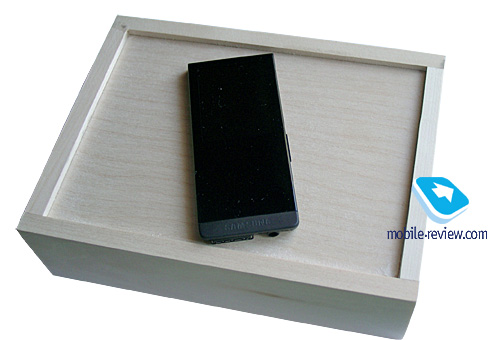
Controls
The controls scheme, already seen in the K3 (X-Metal), the K5 (Dynamix) and the Dynamix second generation device, the S5, has been adopted by the T10, the new Indigo. As you might have already guessed, the player employs touch-sensitive controls, which is nothing new.
Below the display sit seven touch-sensitive pads. Five of them form a conventional five-way navigation key and will help you in browsing the T10’s menus, lists, adjusting volume, confirming your choices and other affairs. The other two stand for the context-sensitive menu and return to the previous menu level.
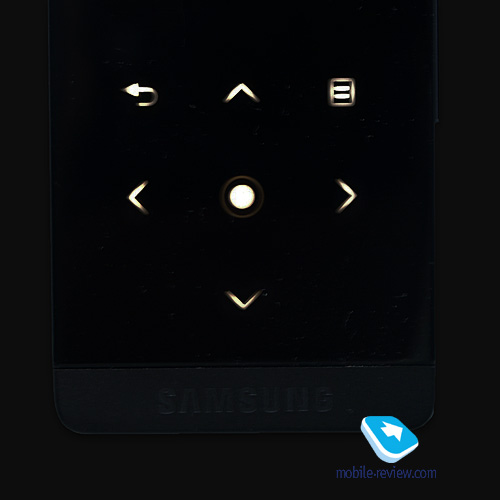
In view of these touch-pads average sensitivity, they take some getting used to – the number of misclicks grows thin as time goes by and you get more experienced. On the whole this controls scheme can be mastered in a very intuitive way without having to read though manuals or start-up guides.
The side plate houses another control – a toggle switch. If I remember it right, it was Creative’s invention in the first place, but these days similar solutions are ubiquitous. You can move it to one direction, and it will stay that way unless you push it back – this will actually lock the T10’s controls. And when pressed towards the opposite end, it comes back to the initial position, for this action turns the T10 off.

Display and menu
Over the last months, all top players seem like have inked and held on to a secret standard – 320x240-pixel resolution and 2-inch plus diagonal, otherwise they risk getting booted. In fact, that’s the screen the T10 ships with. The player it displays is great, and to tell the truth, that’s the only thing I expected to see from a Samsung-branded device. Not because I favor this maker’s products or promised to give this player “A”s on all tests. The fact of the matter is that a display manufacturer can’t and really should embed meagre screens into its solutions. Its brightness and contrast parameters are okay, you’ll definitely enjoy the menu view starring Sammy (the dog), all thanks to its color brilliance. The black-luminescent view also looks decent, however can’t give you an idea of how good this display is.
A few words about Sammy: with the T10 you can go for one of the two menu views. The former – that Sammy view, featuring an animated toon dog, born in Samsung’s halls, and having no alter ego in some cartoon. With this option picked, during the transitions between various items the background will change, while Sammy runs between them, poses, and generally animates the whole process. Honestly, when I first saw this, I couldn’t make any sense of who this was meant for – since this player aims at mature people, while Sammy is very likely to appeal to kids. But then I came to like these cartoons. After all, every adult has a child inside, that’s why Sammy can actually pull the “trigger” inside you. Once I switched the menu view back to the more “adult” black color scheme, it was only ten minutes before I invited Sammy back to the T10’s display. On top of that, there are tons of details on the backgrounds in the Sammy view, which has to be a deliberate move, as the display’s image quality and its sharpness can’t possibly be missed or overlooked this way.
The menu tree has been substantially expanded with some new features. Some of them, the ones you usually find in the foot directory, were moved to a special section.
The new menu tree: Music, Videos, Pictures, FM Radio, Datacasts, Prime Pack, File Browser, Bluetooth, Settings.
Music. Tracks can be sorted by artist, album, genre etc. From here you will call up playlists, adding tracks onto your playlist is done from the context menu.
Videos. Upon picking this item, the display shows you the list of videos you can watch. If the T10’s memory contains a file that it can’t playback, you won’t see it on this list.
Pictures. The display shows eight thumbnails.
FM Radio. Tune in!
Datacasts. Samsung’s version of podcasts – uploaded via Samsung Media Studio.
Prime Pack. This section holds all important options that couldn’t make it to the main menu: text viewer, voice recorder, games, alarm clock, world clock, audio in.
File Browser. Allows browsing the player memory’s contents, enables you to create folders and delete files.
Bluetooth. Every last thing that has something to do with Bluetooth connectivity is found here – activation, device search, modes, file transfer.
Settings. A slew of options and device information here.
Apart from the main menu, the T10 also features context-sensitive menus, housing various functions unique to every mode or shortcuts to the main menu’s items, like the equalizer.
The T10’s menu is laid out in a very intuitive manner and is identical to the S5’s menu tree. The menu’s looks does a pretty good job meshing with this cartoon theme, which is all thanks to the decent displays that have started popping up on many units recently – I doubt that with a 160x128-pixel resolution Sammy would be even a third of what it is now.
Battery life and PC connection
In terms of battery life, the T10 brings no surprises, being a pretty decent performer. It utilizes a built-in battery that can’t be detached, which is what we normally see in players. It seems the type is Li-Pol – no exact data as yet, so we are down to some guess work. And probably it wouldn’t be very nice of us to take apart the only unit available in the company’s office. Charging is done via USB, no mains adapter is shipped with the T10, however there are already available for purchase.
The T10 has a rated battery life of 30 plus hours of playback, which is, I think, pretty great. In video mode the player lasts around four hours. Since it is the only unit they had over at the office for the time being, we had to hand it in a couple of times. That’s why I never managed to charge the battery up to give its music playing abilities a long run-through, nevertheless, judging by the battery indicator, the figures mentioned above aren’t too wide of the mark. And when it comes to video, it does ensure a four-hour long non-stop session, and even adds around half an hour on top of that (I didn’t time it, but that’s the way it felt). However, the video sample I picked for the test was the default Charlie’s Angles trailer, but it was so nice that I couldn’t make myself switch it. Or maybe it had some sophisticated coding to make the player last longer and give you a better picture?
PC connection couldn’t possibly be any simpler with UMS. There is also a variation of the T10 shipping in Russia, that supports both UMS and MTP, and all “western” editions and samples sport MTP protocol only. Which is nothing to be sad about – you still see the T10’s thumbnail in My Computer, allowing you to get music onto your T10 by dragging and dropping required tracks. Furthermore, you can store file types not supported by the player, so as to employ it as a mass storage device. In contrast to the S5, the data transfer speed provided by the T10 is substantially higher – around 5 Mb/s.
Video, photo, other features
The video experience I got with the T10 was pretty much favorable – in many ways that’s exactly what you feel about the Sony A800’s video. While watching video with this display no longer causes any pain in your eyes, I would say it inclined more towards clips rather than full-length movies. Videos look sweet on this T10 – much of the credit goes to the display found here. Unfortunately, no standard formats are supported, so you are bound to encode all video clips on your own, but in return you get the best possible quality for the player’s display, which is quite something. The thing I really loved was the smooth playback, frames per second was definitely the point were T10 fell flat. The process of video conversion doesn’t take long, however it greatly depends on file size and your PC config, so there is no reason to give any exact figures here.




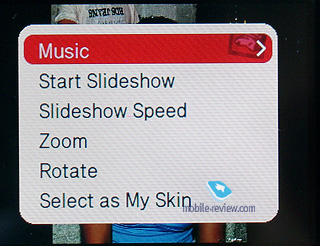
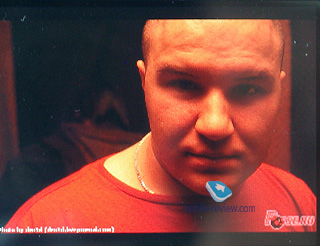
On the other hand, the image viewing front has everything you need in stock – the display shows up to eight thumbnails, and on top of that, all these icons appear to be well-detailed, so you can even discern something. There is no way you can zoom in/out, instead you are enabled to rotate images, which is a great thing that we meet not as often as we would like. Photos can be also viewed in the slide-show mode or set as the display background. Another thing of note is that big photos take a couple of seconds to load, which is fine. But when they actually do, the quality turns out to be beyond expectations, again, thanks to the display.
The no-frills FM-tuner found in the T10 can record broadcasts, and we think we are quite content with this alone. The player can keep up to 25 radio stations in memory, which is already quite insufficient for Moscow. Nevertheless, you favorite broadcasts will fit this limit just fine.
Thankfully, the T10 manages text files in a convenient fashion – it recognizes Unicode, and, more importantly, has no quarrel with files bigger than 1 Mb. You are free to setup background color and font size, which is not par for the course today.
Strange, but the more sophisticated T10 lags behind the S5 in terms of recording quality – only one quality level available. However, it may come, that this is a trait of the prototype’s firmware version 0.55.
The point of interest here, however, is the T10’s Bluetooth connectivity. The player comes with Bluetooth 2.0, which, technically, means pretty fast data connections – three times faster than normal or so. Nevertheless, as long as the FTP profile (for trading files back and forth) is missing from the T10’s software, the only thing it can do is beam sound to wireless headphones. It is good to find the AVRCP support in the T10 – this profile is responsible for playback control from a wireless headset or earphones. In its day the original Indigo suffered an avalanche of attacks from users willing to trade their data between each other, for this to happen they had to update the firmware, whereas an Internet connection isn’t available everywhere you can get an mp3-player. But I suppose the release candidate of the revamped Indigo will come armed with FTP profile. A pity, though, that we didn’t have a chance to test it.
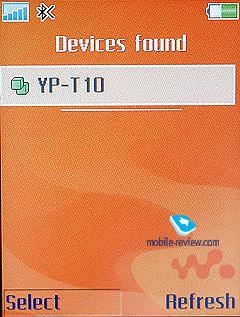
There is another strange thing to the Bluetooth connectivity found in the T10; however, it is more a positive trait, being a stand-alone feature that we would like to breakdown here. Specifically this is the ability to beam sound to two compatible pairs of earphones or a pair of earphones and a stereo system. Nevertheless, I don’t see how useful this option may prove to be. Probably, there will be couple that would love to listen to some tunes together, but what's the point in sending the same music you hear in your earphones to a stereo system?
Sound
I would really like to write here only three words “It sounds good”, and then move straight to the Conclusion section. But I’m ought to give you a lowdown, even though no man hears the same thing as his neighbor, so there is no escape from two camps: lovers and haters. But enough of this mumbling, it’s time to do business. The T10, just as you would expect from it, outputs smooth sound curves, basically all Samsung’s latest and greatest players boast very balanced Frequency response curves and decent sounding. All that is left to do is pick a pair of headphones that suit you best and enjoy just about any genre. The best choice for this case will be no-frills mid-tier in-ear design headphones, since the player won’t be able to handle over band type headphones; in fact it has been made to get along with earbuds and light clip-on earphones.
General performance
| Frequency response (from 40 Hz to 15 kHz), dB: |
+0.12, -0.42 |
Good |
| Noise level, dB (A): |
-86.1 |
Good |
| Dynamic range, dB (A): |
86.1 |
Good |
| THD, %: |
0.0042 |
Very good |
| IMD, %: |
0.022 |
Good |
| Stereo crosstalk, dB: |
-87.4 |
Excellent |
| Intermodulation at 10 kHz, %: |
0.042 |
Good |
General performance: Good
Frequency response

Noise level

The pair of headphones coming packaged with the T10 is pretty much standard – similar units ship with some other models as well. Even though there is nothing special about them, they sound pretty good for a pair of default earphones. But obviously, they will never disclose the player’s true potential, so after a while you are very likely to ditch them in favor of something more sophisticated.
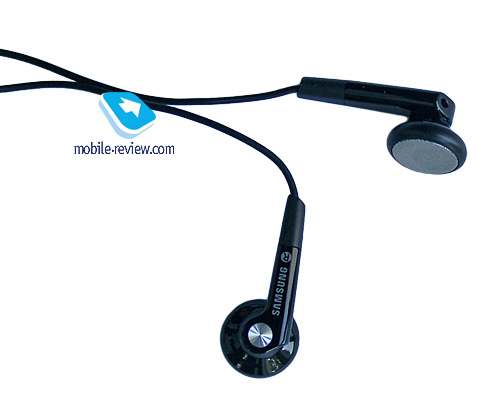
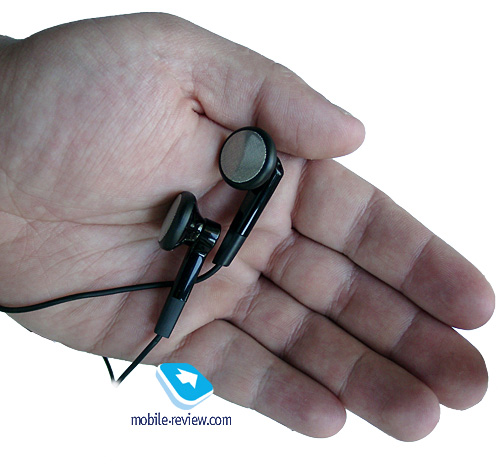
Conclusion
When I was wrapping up this review, I couldn’t stop longing for the now-gone shapes of the original model, but actually got somewhat warmer towards the T10’s casing. It is extremely palm-friendly, and delivers nice tactile feel with its metal and plastic parts. After all, there must be some smart men elaborating, calculating and them implementing all these things. The fact of the matter is that in spite of its fingerprints-prone surface, the T10 is a joy to have in hands, play around with, or punch some touch-sensitive buttons on. While thin is in at only 8 mm, the T10’s casing doesn’t feel fragile and it is certainly a lightweight. Again, I won’t criticize Sammy with its grimaces and jumps taking place against the background of all these already-prosy menus. It may well be that Samsung is currently making first steps towards the new interface type for portable devices. Many manufacturers do somersaults to make their offerings synonymous to fun and joy, and at the same time can’t see such a simple, yet very entertaining and flamboyant way to implement the menus of their solutions.
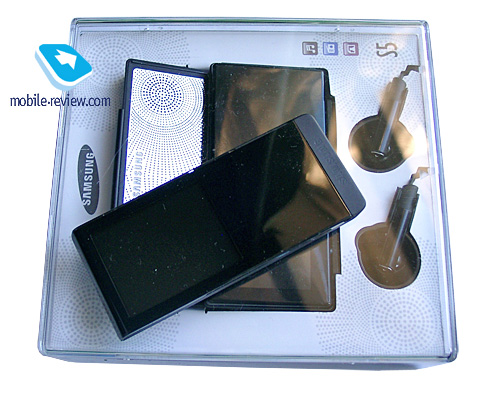
All up, the successor is worthy of the original player – the T10 takes down the K3 with ease, thanks to its display in the first place. I think it deserves getting onto my personal list of favorite players along with the Cowon D2 and the Sony A800. I’m also thrilled about putting the T10 and the new Nano up against each other; I hope there will be a comparative review some time in the future.
Undoubtedly, this player will be a success here in Russia. Wrapping it all up, here is what’s good about it: finely crafted casing, very “touching” and the display. There rest is just fine. I can’t fault the T10 for something crucial, since for the most part the negatives include insignificant details like its proprietary socket, rather than a miniUSB connector. So, that being said, our verdict on the T10 is… a solid player for everyone with a decent display, that has what it takes to go high up the sales chart.
Specifications:
- Memory: 2/4/8 Gb
- Supported formats: MP3, WMA, OGG, AAC, SVI (MPEG4)
- Color schemes: Black, Red, Green, White, Grey
- Display: 2 inches, TFT, 320x240 pixels
- Power: built-in battery
- Battery life: 30/4 hours
- Dimensions: 96x41.5x7.9 mm
- Weight: 43 g
Alexander Dembovsky (alexander.dembovsky@mobile-review.com)
Translated by Oleg Kononosov (oleg.kononosov@mobile-review.com)
Published - 16 October 2007
Have something to add?! Write us... eldar@mobile-review.com
|
News:
[ 31-07 16:21 ]Sir Jony Ive: Apple Isn't In It For The Money
[ 31-07 13:34 ]Video: Nokia Designer Interviews
[ 31-07 13:10 ]RIM To Layoff 3,000 More Employees
[ 30-07 20:59 ]Video: iPhone 5 Housing Shown Off
[ 30-07 19:12 ]Android Fortunes Decline In U.S.
[ 25-07 16:18 ]Why Apple Is Suing Samsung?
[ 25-07 15:53 ]A Few Choice Quotes About Apple ... By Samsung
[ 23-07 20:25 ]Russian iOS Hacker Calls It A Day
[ 23-07 17:40 ]Video: It's Still Not Out, But Galaxy Note 10.1 Gets An Ad
[ 19-07 19:10 ]Another Loss For Nokia: $1 Billion Down In Q2
[ 19-07 17:22 ]British Judge Orders Apple To Run Ads Saying Samsung Did Not Copy Them
[ 19-07 16:57 ]iPhone 5 To Feature Nano-SIM Cards
[ 18-07 14:20 ]What The iPad Could Have Looked Like ...
[ 18-07 13:25 ]App Store Hack Is Still Going Strong Despite Apple's Best Efforts
[ 13-07 12:34 ]Infographic: The (Hypothetical) Sale Of RIM
[ 13-07 11:10 ]Video: iPhone Hacker Makes In-App Purchases Free
[ 12-07 19:50 ]iPhone 5 Images Leak Again
[ 12-07 17:51 ]Android Takes 50%+ Of U.S. And Europe
[ 11-07 16:02 ]Apple Involved In 60% Of Patent Suits
[ 11-07 13:14 ]Video: Kindle Fire Gets A Jelly Bean
Subscribe
|









